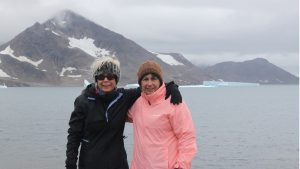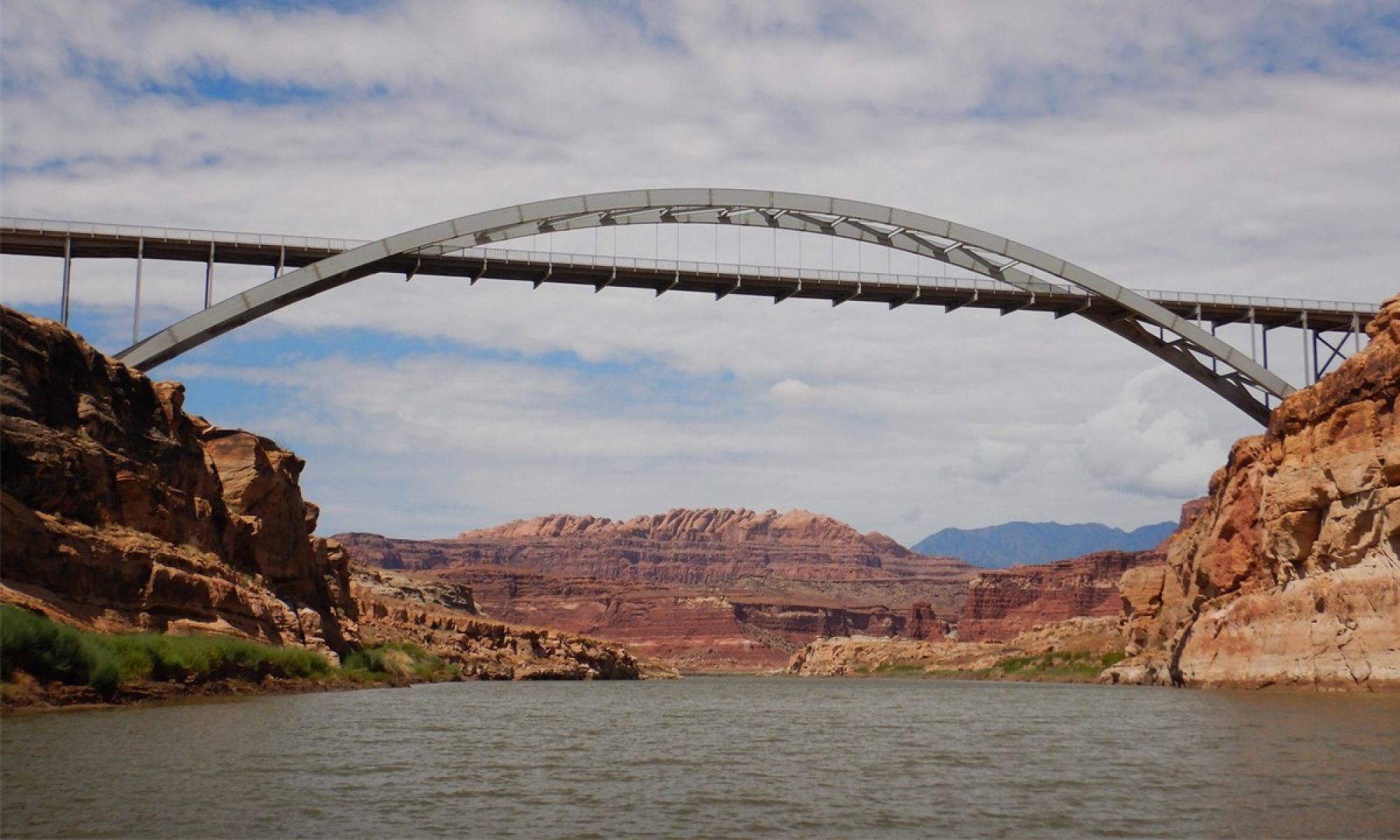August-September 2018
Greenland – The Island of Ice & Snow
We had already had a visit to Iceland planned, so it only made sense to take an extension and use the opportunity to visit Greenland. Greenland only has a population of ~57,000 with most of them living in a few towns on the southern east coast. We, however, are going to visit the southern west coast where small, isolated towns are populated by Inuit residents, many of them living similar lives as their ancestors.
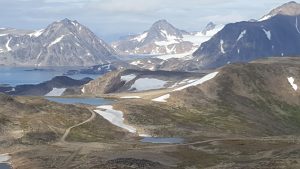
The nine of us flew a 2-hour “domestic” international flight from Reykjavik, Iceland to the airport at Kulusuk island housing the community of the same name – Kulusuk, Greenland. Our plane was a rather new 60-seat plane that had quite a diverse collection of people on-board, including a number of hikers and kayakers. Once we collected our luggage, we caught a local van for the 1-mile trip to the Kulusuk Hotel, a small, rustic building located between the airport and the Kulusuk Community. The community of Kulusuk was the last native settlement in Greenland discovered by the Western World around 1900. At that time, the community was around 400 people – today the population has dropped to 200 people. After checking in, we took a hike down to the pier and tanks located nearby on the island’s bay. From here, we walked further out onto the peninsula looking at the local flowers and marveling at the parade of icebergs floating through the straights. After returning to the hotel for a buffet lunch, we gathered in the van and took a drive 1000 feet up the coastal mountains to a abandoned USA radar station – “Difour”. It was originally built in 1956 as part of NORAD’s 10 radar stations that ran from Alaska to Greenland to provide early warning for any missile attacks coming over the North Pole. When US personnel were stationed here, they were not allowed to leave the base and visit town or mix with the local villagers. The facility was removed after the fall of the Berlin Wall and the end of the Cold War. From the top of the cleared military base location, we had a spectacular 360-degree view of the mountains on one side, and the north Atlantic on the other, with its huge icebergs moving along the coast. After our drive, it was back to the hotel for a brisk 30-minute walk down to the community of Kulusuk. The town has a grocery, post office, school, church (Lutheran), museum and a boat dock and small harbor. This town can only be accessed by air or by boat, but boats can only travel here between June through September, as the polar ice-pack make access impossible. Since snow in this area can easily reach 5-meters in height, these towns must have a high degree of self-sufficiency during their brutal winters with only a small amount of emergency supplies available by air for two-thirds of the year. In town, we explored the local grocery and church before walking back to the hotel to unpack and get ready for dinner. After dinner, a local Inuit Dancer came to perform a “Drum Dance”. The “Drum Dance” was a local tradition which is slowly disappearing, but she performed a haunting sing-song chant with a rhythmic drum-beat while dressed entirely in beaded seal-skin, from boots to headdress.
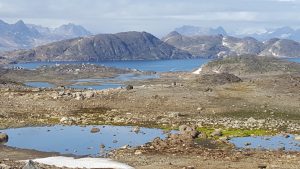
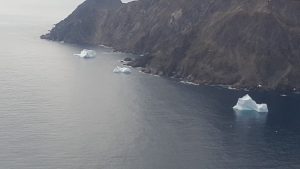
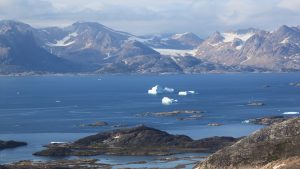
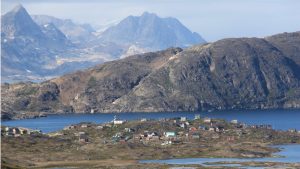
That night saw a weather-front move-in, bringing rain, 50-60 mph wind-gusts and 40-degree temperatures, which cancelled our planned helicopter flight to the village of Tallisaq. Although only 25 kilometers away, Tallisaq is on a different island, and transport in this region is weather dependent, and relies on regular helicopter flights as the local form of “bus” transportation. The weather confined us to the hotel for movies, reading and games of cards until late in the afternoon, when it let up enough for a brief stroll outside. The storm brought fresh snow to the mountain-sides and moved a new series of icebergs into the waters around our island. After dinner, our Danish van driver recounted his recent 20-month retirement “trip-around-the-world” with power-point slides and personal stories. He would be leaving the island with us and returning home to Denmark, as the end of Greenland’s visiting season was quickly arriving and winter would be here soon.
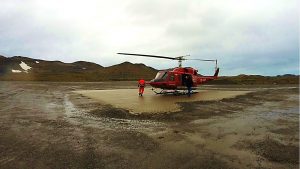
The next morning brought good weather, and after breakfast, we made the short journey back to the Kulusuk Airport for our Greenland Air helicopter flight to Tallisaq. Our helicopter was a 9-passenger version which completed the 9-minute flight quickly but gave us spectacular views of the waterways and landscapes around us. Upon arrival, the hotel van transported us up the side of a hill to our lodging, a hotel owed by the same brothers with whom we stayed in Kulusuk. Here, we dropped our luggage, and shuttled to the beginning of a trailhead to hike into the Valley of Flowers. The hike starts past a few village dog kennels, which are often at the edge of villages. These sled dogs are not pets, and they are kept chained outside and fed a diet of raw meat 3 times a week. These towns and villages each have assigned quotas for native hunting for polar bears and narwhales, (seals are unlimited). Once past the kennels, we explored the village’s cemetery – an organized collection of graves, each with an identical unmarked white cross. The Inuit believe that names should not be on the graves, and they should be “freed” to be used by the living. Past the cemetery, the trail undulated up and down past ponds and lakes and hillsides of colorful flowers, before we arrived at a waterfall, and began the journey back. At the hotel, we had a buffet lunch before leaving for a walking tour of town. The church here is hexagonal with a picturesque landscape of the area painted on the ceiling. Tallisaq has ~1000 residents and is the 6th largest village in Greenland, and the largest on the East Coast. In fact, all East Greenland is home to only 3000 residents. In Greenland, no one can own land, and one must get a permit from the government to build, and there is quite a bit of government-supplied housing available at ~3000 Kr/month. The economy of Greenland is fully supported by Denmark, even though Greenland has some autonomy in the operation of its affairs. In fact, there is no army in Greenland, and the police force is completely provided by Denmark. In Tallisaq, the homes have running water and flush toilets, where nearly none of the surrounding settlements do. Like Kulusuk, there is no access to the town by sea from October through June. When the first ship arrives in summer, the town fires its 3 cannons, and the town gathers at the dock to unload long-awaited supplies. The cannons fire again on the town’s biggest holiday – the Summer Solstice on June 22nd, and a final time when the last ship of the season departs in October. Hunting and fishing are critical to their surviving the harsh winter. This year, Tallisaq had a 30 polar bear limit, which was already filled. Tradition has it that the person who sights a polar bear, the person who kills it, and the person who touches it first are all entitled to share its meat. It is illegal to pay to hunt in Greenland. Here, the traditional drum dance and the local shaman have both disappeared. School here is only grades 1-9, with 10th grade optional and necessary for University entry in Western Greenland. Those not going to University, go to “Nuk”, or local trade school, and in either case, all schooling and teachers in the country are paid by the Danish Government. While in town, we visited a local craftsman shop where narwhale tusks were being carved, went to the town’s post office, and visited an old turf-house which was made to house ~25 people through the winter. Next, we walked to the harbor where we boarded a local ship. We had to navigate our way out since the previous week’s storms had grounded an iceberg right at the harbor’s entrance. Once on the open water, we toured the fiord where we saw numerous icebergs. Upon returning, we traveled back to the hotel for dinner, and watched a 1938 B&W movie filled in the town with locals playing all the roles. The film was a drama, but it depicts well the customs and people of the time, and many of the town’s residents today are related to those in the film.

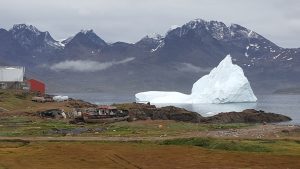
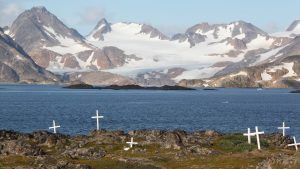
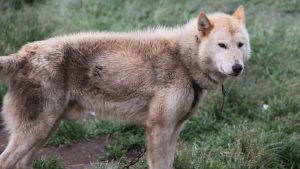
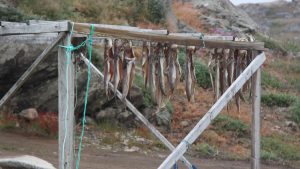

The next morning ended our trip here, and we helicoptered back to the airport in Kulusuk. Here we had a long layover and great weather, and so we took the opportunity to take one final walk for 2.5 hours out to the end of the island’s peninsula before returning to our former hotel for lunch and goodbyes. We then departed Greenland and arrived back in Reykjavik at 7pm, had a group dinner and revisited our adventures with all our new friends. The next morning, it was on to the International Airport and everyone’s trip home.
